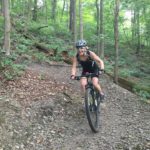
Bunny Hops and Changing Behaviors
We were rolling through the woods on our bikes when a large obstacle on the trail appeared around the bend. I had been experimenting with and practicing a new skill that I had learned (bunny hopping over logs) so when I came around that bend, I told my friends that I was going to jump it. A bunny hop is launching your bike into the air as if jumping off a ramp. The pedals on the bicycle “stick” to your feet as the bike becomes airborne. You can bunny hop over some pretty large obstacles by doing this correctly.
So, I prepared myself with my inner checklist of what I needed to do in order to successfully jump this log:
- Pull up on the handle bars by shifting my weight and leaning back (front tire goes up)
- Lean forward to pull up back wheel off the ground
- Hang on (grip tightly) and land with both wheels on the ground (pointed forward, of course)
With the help of a small downhill, I was able to get up enough speed and successfully jump in just a matter of seconds.
Bunny Hopping in Montour Woods_player
Now you may be interested to know that the process of learning this fun and useful little mountain biking trick is the same process that occurs when you learn any new habit. It’s one that I teach to all my clients and this is how it goes.
Suppose that the new habit you are learning is to speak without word fillers (um, like, you know what I mean…). Here are the stages of developing a new skill/habit:
Stage 1: Total Lack of Awareness—not realizing there is something wrong or that you can do something to improve your current situation or behaviors. There is no way that you change a behavior unless you know a certain bad habit exists. So, at this stage, you have to enlist the help of someone else to help you identify if you used word fillers. Alternately, you can make a recording of your speech and then listen to it and count the number of times you use a word filler.
In my biking example, jumping over logs wasn’t even on my radar when I first started to bike. I was most interested in staying on my bike.
Stage 2: Conscious Awareness—you are aware of your own mistakes/wrong ways of doing something and when it happens, you know it and feel uncomfortable. Once you have the awareness that word fillers are occurring way too frequently, you will suddenly begin to notice your distraction… a lot. Do you know how uncomfortable this is? It’s terribly uncomfortable! But it is of course, a necessary stage in the process.
With mountain biking, I noticed my biking friends jump those obstacles that I was getting off and carrying my bikeover while my friends sped away. I was uncomfortable holding them up as they waited for me and uncomfortable thinking about jumping obstacles in order to keep up.
Stage 3: Conscious Application of a New Skill— you are repeatedly practicing a new skill to change old habits. It requires intention and concentration. You know that you say “um” too often (maybe you’ve timed yourself for a minute and discover that it happens 30 times in 60 seconds.) Now, its time to figure out what you are going to do differently. Will you get comfortable with the pause? Will you learn to take a breath? Will you slow your speech down? Whatever it is, you intentionally practice the skill over and over again. You will need to practice frequently and in many different settings. From my own experience, and from what I’ve experienced with my clients, just because you know a problem exists and you know what to change, doesn’t mean it will happen!
In my story, I learned to bunny hop by watching YouTube videos and practicing with patient friends. We practiced in my yard on flat ground over a small branch. Then I progressed to larger obstacles as I gained more confidence before heading to real life obstacles in the woods. It took a lot of courage, practice and concentration.
Stage 4: Automation —the new skill is achieved and it becomes automatic. In Stage 3, you intentionally practiced frequently and in many settings over a period of time so that you were training your brain to react differently. In Stage 4, the behavior becomes automatic and you no longer have to concentrate on the skill anymore. This is important because high stakes conversations and presentations require you to be present with the topic and pay attention to other important aspects. You don’t want to have to worry about your word fillers.
I haven’t reached this level yet with my bunny hopping. I’m still in Stage 3 practicing. But I know that with enough practice, I will be bunny hopping as naturally as my more experienced biking friends. And in the meantime, I’m having a lot of fun trying. I hope that you, too, will enjoy the process of developing your new skill.
*****
Do you need help achieving your communication goals? Schedule a strategy call and we’ll discuss ways to do that.
